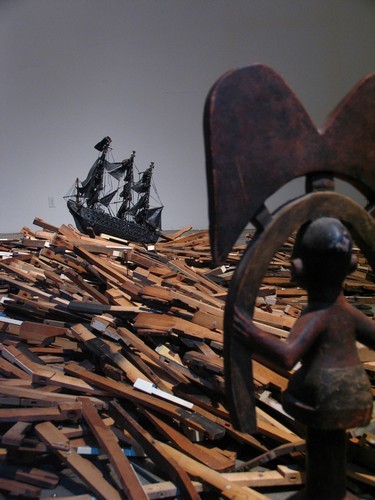NeoHooDoo
Art for a Forgotten Faith
19 Oct 2008 - 26 Jan 2009

Storm at Sea, 2006
Piano keys, African sculpture, model boat, paper, acrylic, glitter, and gold leaf
212 x 213 inches
Courtesy of the artist and Jack Shainman Gallery, New York
Including some 50 works of sculpture, photography, assemblage, video, performance, and other media, NeoHooDoo asserts that the drive towards a spiritual practice is as relevant today in our burgeoning global society as it has ever been. Artists have long engaged with ritualism to enrich their work, drawing on the traditions of shamans, griots, and oral historians. NeoHooDoo“grew out of a desire to explore the multiple meanings of spirituality in contemporary art,” states P.S.1 Curatorial Advisor and Menil Curator of Modern and Contemporary Art Franklin Sirmans.
In the late 1960s poet Ishmael Reed adopted the 19th-century term “HooDoo,” referring to forms of religion and their practice in the New World to explore the idea of spiritual practice outside easily definable faiths or creeds and ritualism on contemporary works of literature and art. “Neo-HooDoo,” he writes in his 1972 collection of poetry, Conjure, “believes that every man is an artist and every artist a priest.” His seminal poems, “The Neo-HooDoo Manifesto” and “The Neo-HooDoo Aesthetic,” delve even deeper into this artistic practice to demonstrate its vitality as an international, multicultural aesthetic that embraces spiritual creativity and innovation.
From Vancouver to Havana, Guatemala City, and Bahia, the artists in NeoHooDoo began using ritualistic practice as a means to recover “lost” spirituality and to reexamine and reinterpret aspects of cultural heritage throughout the late 1970s and early 1980s. Visual artists from across the Americas, such as Jean-Michel Basquiat (1960–1988), José Bedia (b. 1959), Rebecca Belmore (b. 1960), Jimmie Durham (b. 1940), and Ana Mendieta (1948–1985) have freely combined disparate materials and mediums to create spaces where art and audience can interact unhindered by history or societal constraints. For these artists, ritual practice often emerges as a form of catharsis and political critique to approach issues such as race, gender, slavery, and colonization. This exhibition also will look at younger artists such as video artists Michael Joo and Regina José Galindo, who carry on many of these practices and themes decades later, reconfiguring the work of their predecessors into performative displays of ritual through film and gallery installations.
Challenging conceptions of “insider” and “outsider” art, the artists in the exhibition frequently create work using everyday objects that resonate both within the confines of a gallery or museum and among their own localized audiences who may or may not visit art institutions. Situating their work in a vernacular aesthetic, the meaning of the work fluctuates according to its context. Items such as light bulbs, wine bottles, artificial flowers, piano keys are repositioned in assemblages confronting themes of exploitation, genocide, and poverty. The 53 pieces of discarded waste paper comprising Jimmy Durham’s A Street-level Treatise on Money and Work are brought to the center of a dialogue on the destruction of native cultures and Dario Robleto addresses American notions of manifest destiny in Deep Down I Don’t Believe in Hymns by taking a military-issued blanket and “infesting” it with hand-ground dust made from vinyl recordings of Neil Young’s “Cortez the Killer” and Soft Cell’s “Tainted Love.”
Franklin Sirmans developed NeoHooDoo as one of P.S.1’s curatorial advisory programs, a unique system that allows diverse curators to present experimental exhibition work. Current curatorial advisors include Chief Curatorial Advisor Klaus Biesenbach, Senior Curatorial Advisor Neville Wakefield, Andrea Bellini, Phong Bui, Lia Gangitano, Susanne Pfeffer, and Franklin Sirmans.
NeoHooDoo: Art for a Forgotten Faith will be accompanied by a fully illustrated catalogue featuring texts by Arthur C. Danto, Greg Tate, Robert Farris Thompson, Jen Budney and Julia Herzberg. The catalogue will also include an interview with Ishmael Reed by Franklin Sirmans and a work by renowned poet Quincy Troupe. The fully illustrated, color catalogue will be available for purchase at Artbook @ P.S.1 (144 pp., $45.00).
Artist List:
Terry Adkins, Janine Antoni, Radcliffe Bailey, José Bedia, Rebecca Belmore, Sanford Biggers, Tania Bruguera, James Lee Byars, María Magdalena Campos-Pons, William Cordova, Jimmie Durham, Regina José Galindo, Felix Gonzalez-Torres, David Hammons, Michael Joo, Brian Jungen, Kcho, Marepe, Ana Mendieta, Amalia Mesa-Bains, Pepón Osorio, Adrian Piper, Ernesto Pujol, Dario Robleto, Betye Saar, Gary Simmons, George Smith, Michael Tracy, Nari Ward
The exhibition is co-organized by The Menil Collection, Houston, Texas, and P.S.1 Contemporary Art Center. It was previously presented at The Menil Collection and will travel to the Miami Art Museum from February 20 until May 24, 2009.
The exhibition is made possible by The Friends of Education of The Museum of Modern Art, David Teiger, and with public funds from the New York State Council on the Arts, a State Agency.
The accompanying publication is made possible by the Andy Warhol Foundation for the Visual Arts.
The presentation at The Menil Collection was generously supported by The Brown Foundation, Inc., Houston, Anonymous, William J. Hill, Beth and Rick Schnieders, Sara Dodd Spickelmier and Keith Spickelmier, Barbara and Charles Wright, Michael Zilkha, The Cullen Foundation, Houston Endowment, and the City of Houston.
